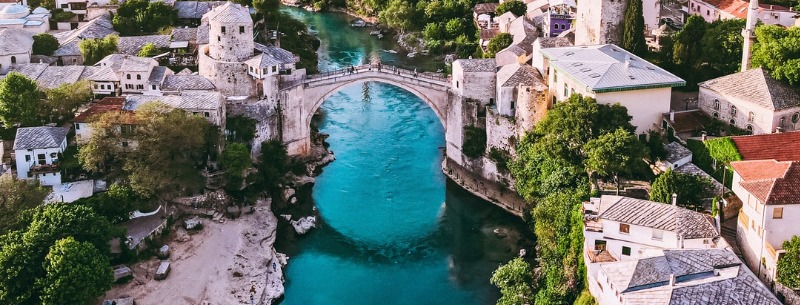Top Bosnia Destinations
Bosnia is an interesting and stunning country with beautiful wild mountains, steep canyons, crystal clear turquoise streams and fascinating cities divided between three distinct cultures (Bosniak, Serbian and Croat).
 Despite its rugged mountains, the snow-covered heights of the Dinaric Alps, the beautiful Una River, and towns like Mostar and Stolac where Ottoman and Byzantine, Roman and Balkan, Slavic, and a plethora of other styles coexist, Bosnia and Herzegovina remains a somewhat off-the-beaten-path corner of Europe.
Despite its rugged mountains, the snow-covered heights of the Dinaric Alps, the beautiful Una River, and towns like Mostar and Stolac where Ottoman and Byzantine, Roman and Balkan, Slavic, and a plethora of other styles coexist, Bosnia and Herzegovina remains a somewhat off-the-beaten-path corner of Europe.
During our Balkan Peninsula by Thumb trip we managed to visit a fair amount of places. Below we present the list of what we consider the most interesting and worth visiting destinations in Bosnia & Herzegovina.
Sarajevo
Sarajevo is one the most historically interesting and varied cities in all of Europe and the crossroads where Roman Catholic west, Eastern Orthodox east and the Ottoman south collide. Simply walking through Sarajevo is a lesson in the rich tapestry of historical influence.
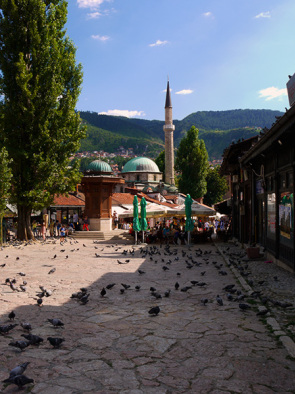
Baščaršija, Sarajevo’s most central district, is a wonderful blend of minarets, grilled kebabs and the pervasive smell of ground coffee, reminiscent of Istanbul but with a Slavic twist. The most interesting monuments of Sarajevo include: Latin Bridge (Yes, it’s here where Archduke Franz Ferdinand was assassinated, which helped to trigger the First World War), Baščaršija (Old Bazaar) and Žuta Tabija (Yellow Bastion). There is also plenty of things to do for FREE in Sarajevo.
Mostar
Architecturally speaking, Mostar is the most beautiful city in Bosnia and one of the finest example of Islamic art in the whole Balkan region. What attracts hoards of tourists every year are the well-preserved stone buildings, cobble-stoned narrow streets, soaring minarets and Stari Most (Old Bridge) – the Ottoman landmark of the city, a UNESCO World Heritage Site and the place where you can see local divers jump into the Neretva.
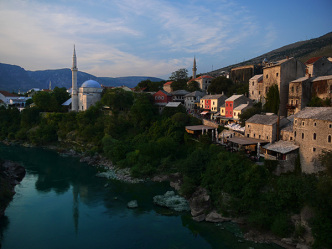
Mostar’s famous old bridge is likely to be familiar to you, as it has established itself as a major tourist attraction in Bosnia and Herzegovina, thanks in part to its proximity to neighboring Dubrovnik (Croatia) and convenience as a day trip. After standing for 427 years, the old bridge (Stari Most) was reconstructed after the 1990s conflict and became famous for its diving competition each summer at the end of Summer.
Jajce
Jajce is a former royal town and a popular domestic travel destination due to its historical importance and the 17-metre waterfall right in the middle of the city. It’s most interesting monuments include: the waterfall, Jajce fortress, and catacombs and underground church. Furthermore, it’s surrounded by beautiful mountains and located near Pliva lake as well as the Vrbas and Pliva rivers.
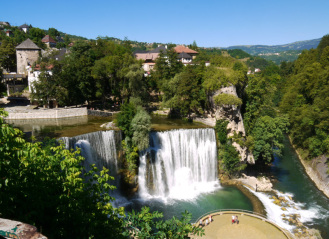
Bosanska Krupa
Bosanska Krupa is a town located between Bihać and Novi Gradin north-western Bosnia. It is set on the green Una river and its main monument is a medieval fortress dominating the town. We found it quite by accident as we got stuck there while hitchhiking but it was a very pleasant place to be stuck in with a really helpful tourist information office, cheap hotel (Stari Grad Ilma, Trg Alije Izetbegovica; 15€/person) and plenty of food & drink options. It’s not a touristy place in the slightest and this is where it’s charm lies.

Jablanica
Jablanica is a town in central Bosnia, located on the Neretva river and Jablanica lake. It’s worth visiting for its stunning mountains if for nothing else and is another place where we got stuck while hitchhiking where the general lack of tourists makes it quite an interesting place. Every evening locals of Jablanica dress up (long dresses, jewellery, high heels, suits etc.) and walk up and down its central street. There are also two discos in the outskirts that play very cheesy music but if you’re into ‘local curiosities’, you will find it interesting. There is also a forgotten soviet hotel for you to explore and stay at. You can beat the price down to 15€/person)
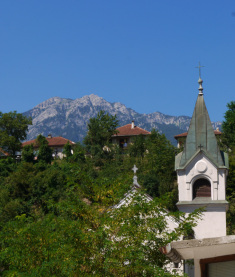
Banja Luka
Banja Luka is the second largest city in BiH and the capital of Republika Srpska. It’s not an obvious tourist destination and many people were surprised we wanted to visit it. It’s a relatively big urban centre full of concrete apartment blocks and busy streets but it has its charms and if you’re after real life rather than polished-up touristy stuff, you’ll like it. Its top tourist attractions include: Cathedral of Saint Bonaventure and Banski Dvor (Governor’s Palace, built in 1930′s).

Travnik
The pretty mid-sized town of Travnik, which is divided by the babbling Lasva River as it flows through the central mountains of Bosnia and Herzegovina, does well to balance its interesting history as the capital and stronghold of the erstwhile viziers of this old Ottoman sub-region and contemporary adventure sports and hiking draws. The first aspect is represented by a strange collection of traditional eastern-style edifices and monuments, two Ottoman clock towers (unique in the country), and a charming 15th-century old town heart. The second aspect can be found on the slopes of Vlasic Mountain, which is now one of Bosnia’s most popular skiing, Nordic walking, and hiking destinations.
Pocitelj
Pocitelj is a small settlement thirty kilometers from Mostar. These two communities are connected by the E73 road. The fortress town may be reached in thirty minutes by automobile. If you use the bus, the journey will take ten to fifteen minutes longer. Finally, from Metkovic to Pocitelj, there are daily buses and tourist tours. In this situation, the journey will take between thirty and forty minutes.
Pocitelj is located in the country’s southern region. The beautiful historic settlement is built at an elevation in a picturesque valley near the Neretva River’s bank. Pocitelj is cut off from the rest of the world by a high wall. The historic town’s East Mediterranean architectural style has been preserved. The historic settlement’s appearance has not changed over time, and it now serves as an open-air museum.
Međugorje
Međugorje is a popular pilgrimage town, whose importance in the Catholic religion is compared to Lourdes or Fatima, due to a reported apparition of the Virgin Mary. I guess, you may want to visit it for two reasons: you are either religious or you find this kind of religious devotion places fascinating and like to explore them with your anthropological eye. We didn’t feel the need to visit it but one of our contributors did and we recommend you read his story.
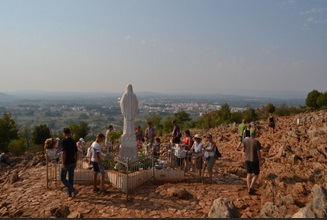
Blagaj Tekke
Built around one of the largest karstic springs in Europe, Blagaj Tekke is a sixteenth century monastery which is tucked precariously between a steep cliff and a labyrinth of underground limestone caves.
The icy waters that are released from the womb of the mountain are turquoise and translucent, designing a picturesque foreground to the monastery. It’s on the UNESCO tentative list and it really looks fabulous. It’s located only 13 km from Mostar and can be visited on a day trip.
Višegrad
Višegrad is a city in the Sarajevo region, on the banks of the river Drina, which is famous for its Mehmed Paša Sokolović Bridge (UNESCO World Heritage Site), and as the birthplace of Ivo Andrić, a nobel prize winner for his novel The Bridge over the Drina. The bridge was build in the 16th century and is a fine example of Ottoman monumental architecture and civil engineering.
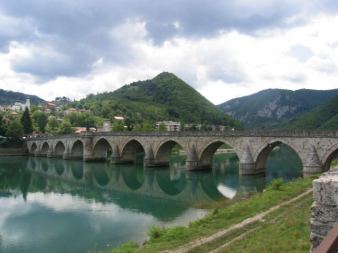
Konjic
The final place we’d recommend as a must-see in Bosnia and Herzegovina is Konjic, a small town in the north. This town’s historic significance makes it a must-stop on your journey. During the Bosnian War, the Konjic region was a vital link between Sarajevo and southern Bosnia and Herzegovina. Aside from heritage, the town is surrounded by some of the most beautiful scenery in the country.
